wheel FIAT DOBLO COMBI 2018 Owner handbook (in English)
[x] Cancel search | Manufacturer: FIAT, Model Year: 2018, Model line: DOBLO COMBI, Model: FIAT DOBLO COMBI 2018Pages: 272, PDF Size: 23.75 MB
Page 143 of 272
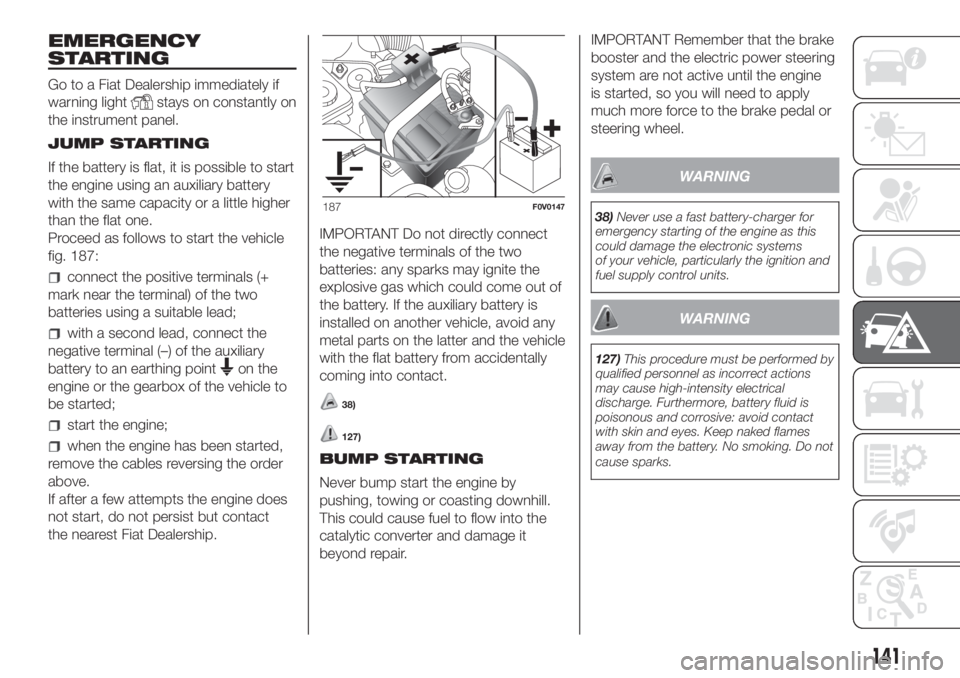
EMERGENCY
STARTING
Go to a Fiat Dealership immediately if
warning light
stays on constantly on
the instrument panel.
JUMP STARTING
If the battery is flat, it is possible to start
the engine using an auxiliary battery
with the same capacity or a little higher
than the flat one.
Proceed as follows to start the vehicle
fig. 187:
connect the positive terminals (+
mark near the terminal) of the two
batteries using a suitable lead;
with a second lead, connect the
negative terminal (–) of the auxiliary
battery to an earthing point
on the
engine or the gearbox of the vehicle to
be started;
start the engine;
when the engine has been started,
remove the cables reversing the order
above.
If after a few attempts the engine does
not start, do not persist but contact
the nearest Fiat Dealership.IMPORTANT Do not directly connect
the negative terminals of the two
batteries: any sparks may ignite the
explosive gas which could come out of
the battery. If the auxiliary battery is
installed on another vehicle, avoid any
metal parts on the latter and the vehicle
with the flat battery from accidentally
coming into contact.
38)
127)
BUMP STARTING
Never bump start the engine by
pushing, towing or coasting downhill.
This could cause fuel to flow into the
catalytic converter and damage it
beyond repair.IMPORTANT Remember that the brake
booster and the electric power steering
system are not active until the engine
is started, so you will need to apply
much more force to the brake pedal or
steering wheel.
WARNING
38)Never use a fast battery-charger for
emergency starting of the engine as this
could damage the electronic systems
of your vehicle, particularly the ignition and
fuel supply control units.
WARNING
127)This procedure must be performed by
qualified personnel as incorrect actions
may cause high-intensity electrical
discharge. Furthermore, battery fluid is
poisonous and corrosive: avoid contact
with skin and eyes. Keep naked flames
away from the battery. No smoking. Do not
cause sparks.
187F0V0147
141
Page 145 of 272
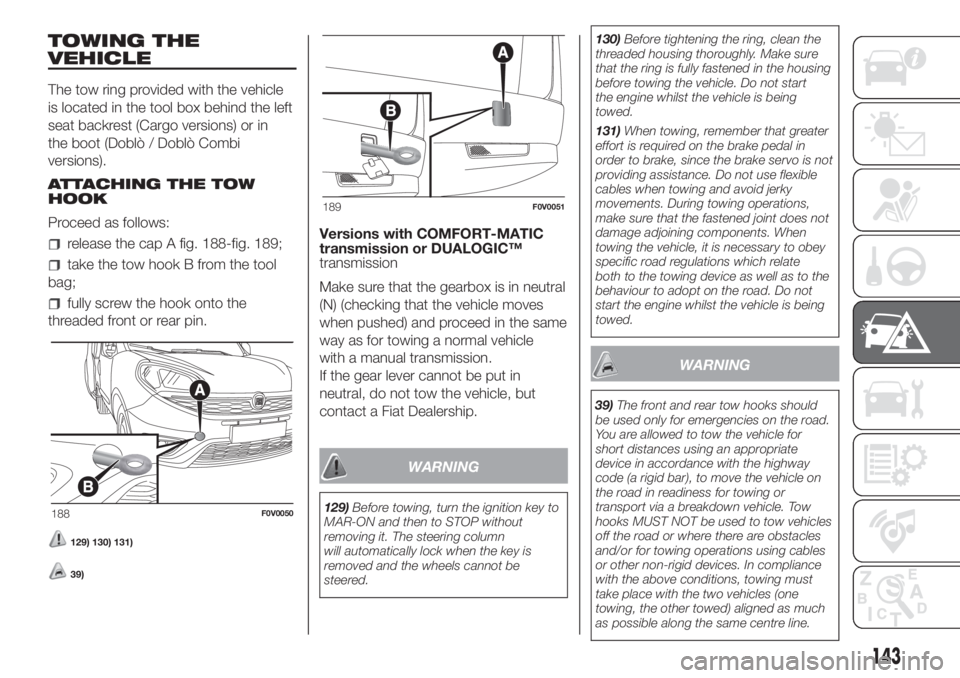
TOWING THE
VEHICLE
The tow ring provided with the vehicle
is located in the tool box behind the left
seat backrest (Cargo versions) or in
the boot (Doblò / Doblò Combi
versions).
ATTACHING THE TOW
HOOK
Proceed as follows:
release the cap A fig. 188-fig. 189;
take the tow hook B from the tool
bag;
fully screw the hook onto the
threaded front or rear pin.
129) 130) 131)
39)
Versions with COMFORT-MATIC
transmission or DUALOGIC™
transmission
Make sure that the gearbox is in neutral
(N) (checking that the vehicle moves
when pushed) and proceed in the same
way as for towing a normal vehicle
with a manual transmission.
If the gear lever cannot be put in
neutral, do not tow the vehicle, but
contact a Fiat Dealership.
WARNING
129)Before towing, turn the ignition key to
MAR-ON and then to STOP without
removing it. The steering column
will automatically lock when the key is
removed and the wheels cannot be
steered.130)Before tightening the ring, clean the
threaded housing thoroughly. Make sure
that the ring is fully fastened in the housing
before towing the vehicle. Do not start
the engine whilst the vehicle is being
towed.
131)When towing, remember that greater
effort is required on the brake pedal in
order to brake, since the brake servo is not
providing assistance. Do not use flexible
cables when towing and avoid jerky
movements. During towing operations,
make sure that the fastened joint does not
damage adjoining components. When
towing the vehicle, it is necessary to obey
specific road regulations which relate
both to the towing device as well as to the
behaviour to adopt on the road. Do not
start the engine whilst the vehicle is being
towed.
WARNING
39)The front and rear tow hooks should
be used only for emergencies on the road.
You are allowed to tow the vehicle for
short distances using an appropriate
device in accordance with the highway
code (a rigid bar), to move the vehicle on
the road in readiness for towing or
transport via a breakdown vehicle. Tow
hooks MUST NOT be used to tow vehicles
off the road or where there are obstacles
and/or for towing operations using cables
or other non-rigid devices. In compliance
with the above conditions, towing must
take place with the two vehicles (one
towing, the other towed) aligned as much
as possible along the same centre line.
188F0V0050
189F0V0051
143
Page 146 of 272
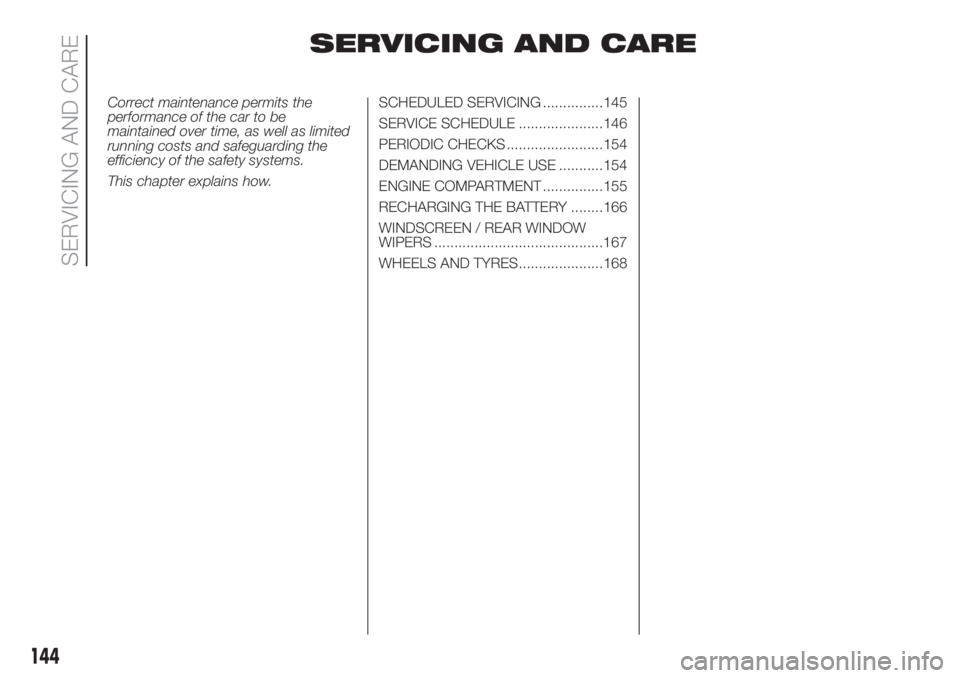
SERVICING AND CARE
Correct maintenance permits the
performance of the car to be
maintained over time, as well as limited
running costs and safeguarding the
efficiency of the safety systems.
This chapter explains how.SCHEDULED SERVICING ...............145
SERVICE SCHEDULE .....................146
PERIODIC CHECKS ........................154
DEMANDING VEHICLE USE ...........154
ENGINE COMPARTMENT ...............155
RECHARGING THE BATTERY ........166
WINDSCREEN / REAR WINDOW
WIPERS ..........................................167
WHEELS AND TYRES.....................168
144
SERVICING AND CARE
Page 170 of 272
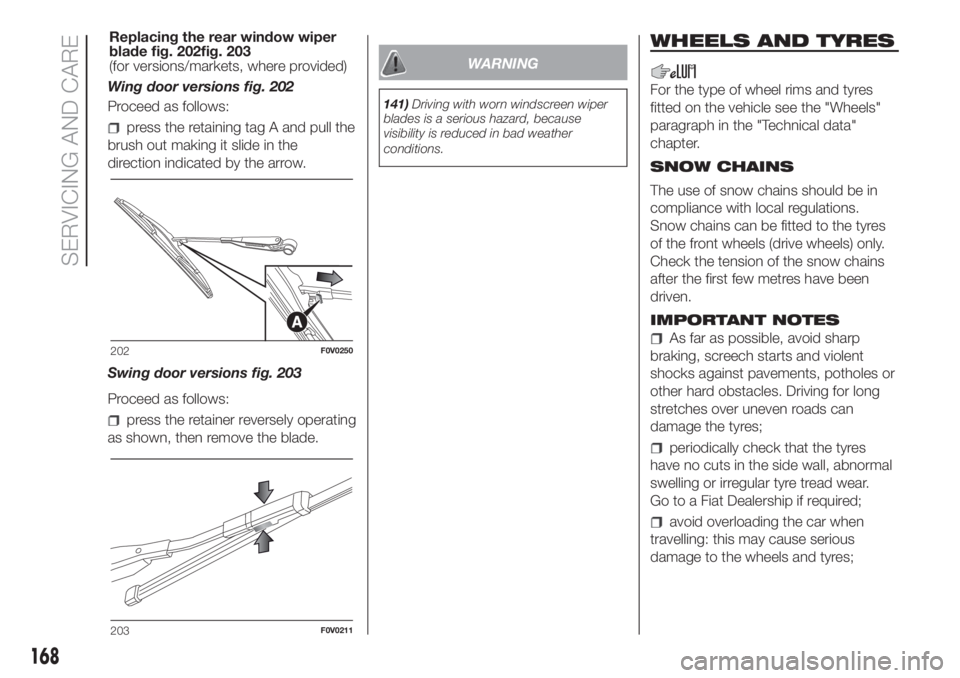
Wing door versions fig. 202
Proceed as follows:
press the retaining tag A and pull the
brush out making it slide in the
direction indicated by the arrow.
Swing door versions fig. 203
Proceed as follows:
press the retainer reversely operating
as shown, then remove the blade.
WARNING
141)Driving with worn windscreen wiper
blades is a serious hazard, because
visibility is reduced in bad weather
conditions.
WHEELS AND TYRES
For the type of wheel rims and tyres
fitted on the vehicle see the "Wheels"
paragraph in the "Technical data"
chapter.
SNOW CHAINS
The use of snow chains should be in
compliance with local regulations.
Snow chains can be fitted to the tyres
of the front wheels (drive wheels) only.
Check the tension of the snow chains
after the first few metres have been
driven.
IMPORTANT NOTES
As far as possible, avoid sharp
braking, screech starts and violent
shocks against pavements, potholes or
other hard obstacles. Driving for long
stretches over uneven roads can
damage the tyres;
periodically check that the tyres
have no cuts in the side wall, abnormal
swelling or irregular tyre tread wear.
Go to a Fiat Dealership if required;
avoid overloading the car when
travelling: this may cause serious
damage to the wheels and tyres;
202F0V0250
203F0V0211
168
SERVICING AND CARE
Replacing the rear window wiper
blade fig. 202fig. 203
(for versions/markets, where provided)
Page 171 of 272
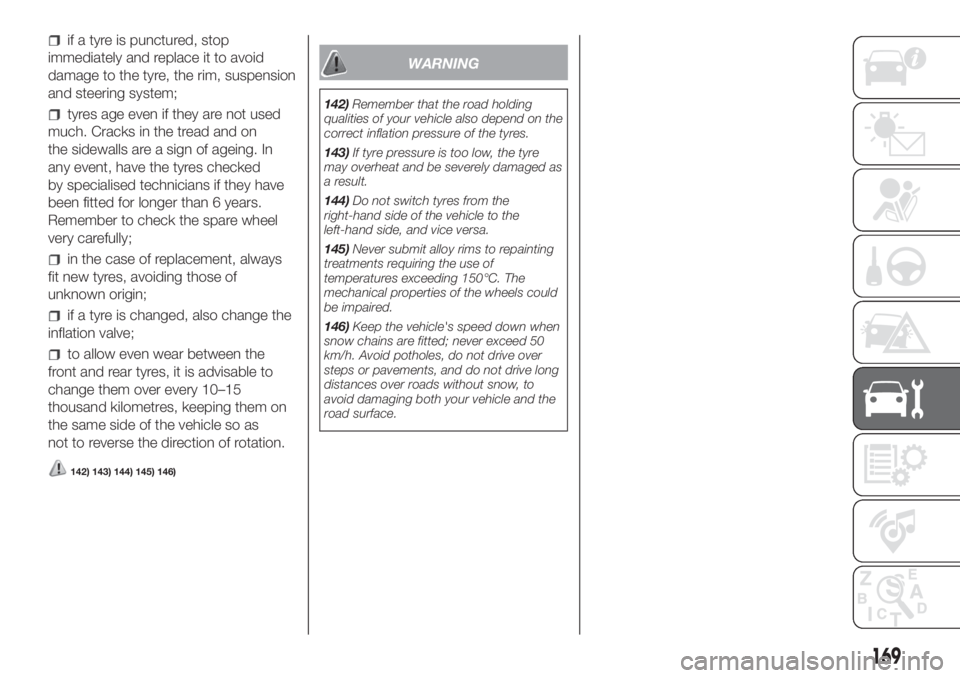
if a tyre is punctured, stop
immediately and replace it to avoid
damage to the tyre, the rim, suspension
and steering system;
tyres age even if they are not used
much. Cracks in the tread and on
the sidewalls are a sign of ageing. In
any event, have the tyres checked
by specialised technicians if they have
been fitted for longer than 6 years.
Remember to check the spare wheel
very carefully;
in the case of replacement, always
fit new tyres, avoiding those of
unknown origin;
if a tyre is changed, also change the
inflation valve;
to allow even wear between the
front and rear tyres, it is advisable to
change them over every 10–15
thousand kilometres, keeping them on
the same side of the vehicle so as
not to reverse the direction of rotation.
142) 143) 144) 145) 146)
WARNING
142)Remember that the road holding
qualities of your vehicle also depend on the
correct inflation pressure of the tyres.
143)If tyre pressure is too low, the tyre
may overheat and be severely damaged as
a result.
144)Do not switch tyres from the
righthand side of the vehicle to the
lefthand side, and vice versa.
145)Never submit alloy rims to repainting
treatments requiring the use of
temperatures exceeding 150°C. The
mechanical properties of the wheels could
be impaired.
146)Keep the vehicle's speed down when
snow chains are fitted; never exceed 50
km/h. Avoid potholes, do not drive over
steps or pavements, and do not drive long
distances over roads without snow, to
avoid damaging both your vehicle and the
road surface.
169
Page 172 of 272
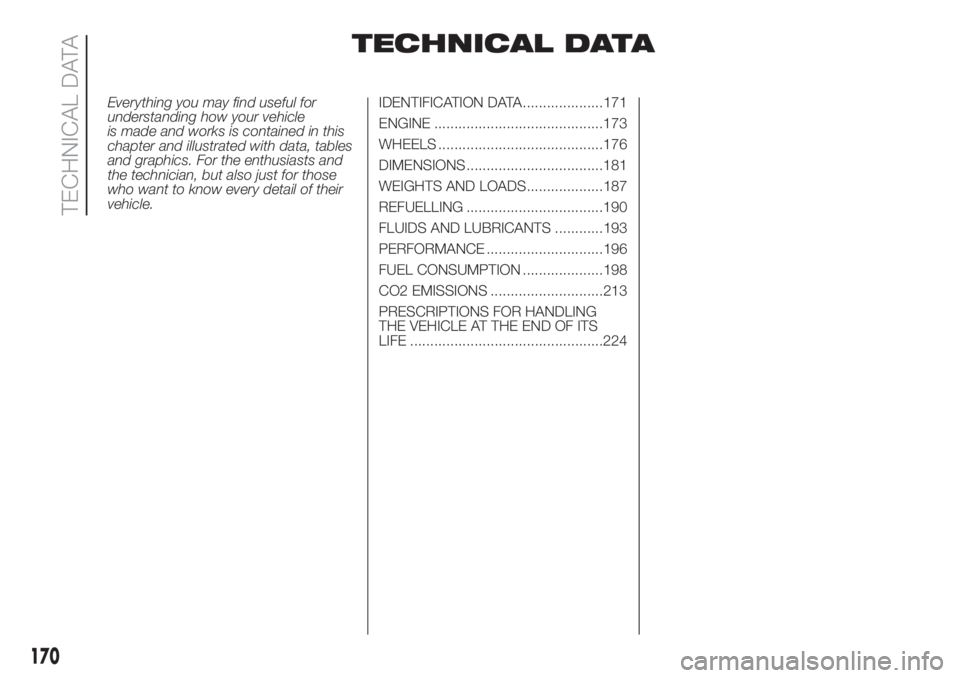
TECHNICAL DATA
Everything you may find useful for
understanding how your vehicle
is made and works is contained in this
chapter and illustrated with data, tables
and graphics. For the enthusiasts and
the technician, but also just for those
who want to know every detail of their
vehicle.IDENTIFICATION DATA....................171
ENGINE ..........................................173
WHEELS .........................................176
DIMENSIONS ..................................181
WEIGHTS AND LOADS...................187
REFUELLING ..................................190
FLUIDS AND LUBRICANTS ............193
PERFORMANCE .............................196
FUEL CONSUMPTION ....................198
CO2 EMISSIONS ............................213
PRESCRIPTIONS FOR HANDLING
THE VEHICLE AT THE END OF ITS
LIFE ................................................224
170
TECHNICAL DATA
Page 178 of 272
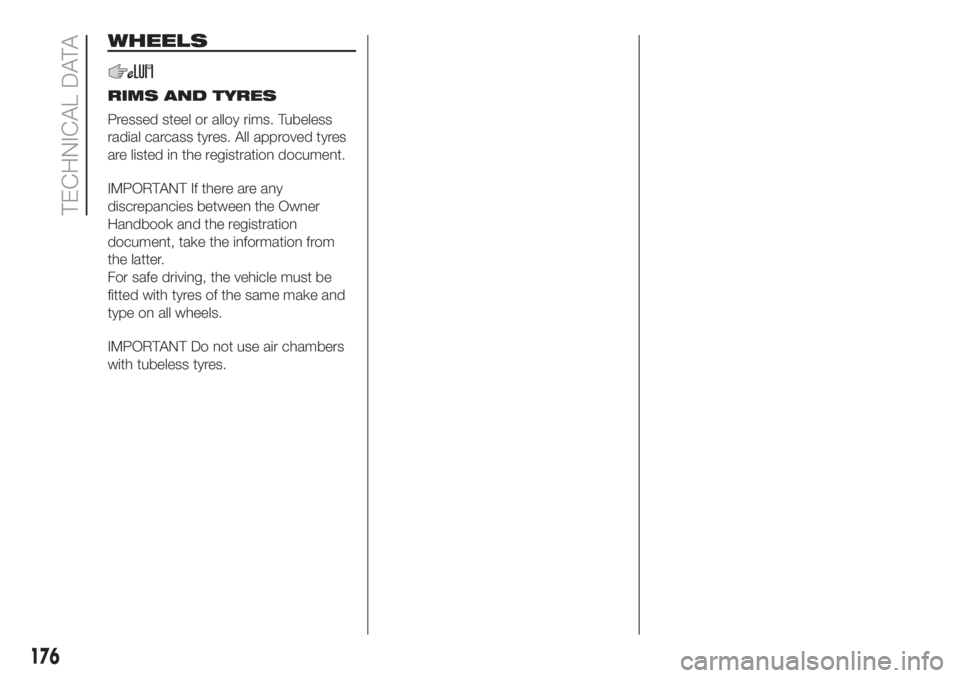
WHEELS
RIMS AND TYRES
Pressed steel or alloy rims. Tubeless
radial carcass tyres. All approved tyres
are listed in the registration document.
IMPORTANT If there are any
discrepancies between the Owner
Handbook and the registration
document, take the information from
the latter.
For safe driving, the vehicle must be
fitted with tyres of the same make and
type on all wheels.
IMPORTANT Do not use air chambers
with tubeless tyres.
176
TECHNICAL DATA
Page 179 of 272
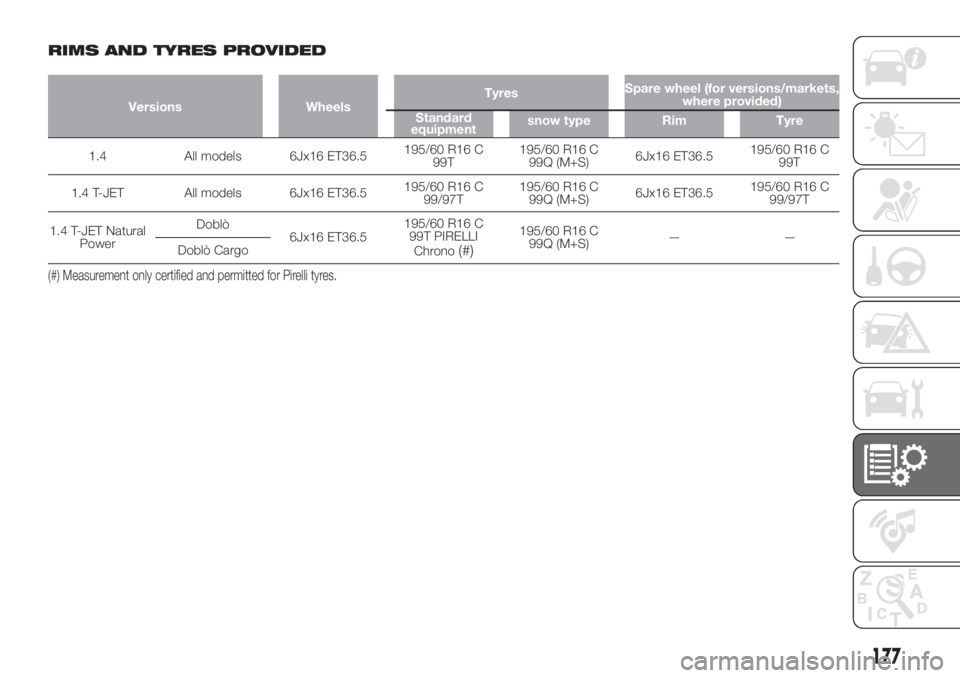
.
RIMS AND TYRES PROVIDED
Versions WheelsTyresSpare wheel (for versions/markets,
where provided)
Standard
equipmentsnow type Rim Tyre
1.4 All models 6Jx16 ET36.5195/60 R16 C
99T195/60 R16 C
99Q (M+S)6Jx16 ET36.5195/60 R16 C
99T
1.4 T-JET All models 6Jx16 ET36.5195/60 R16 C
99/97T195/60 R16 C
99Q (M+S)6Jx16 ET36.5195/60 R16 C
99/97T
1.4 T-JET Natural
PowerDoblò
6Jx16 ET36.5195/60 R16 C
99T PIRELLI
Chrono
(#)
195/60 R16 C
99Q (M+S)——
Doblò Cargo
(#) Measurement only certified and permitted for Pirelli tyres.
177
Page 180 of 272
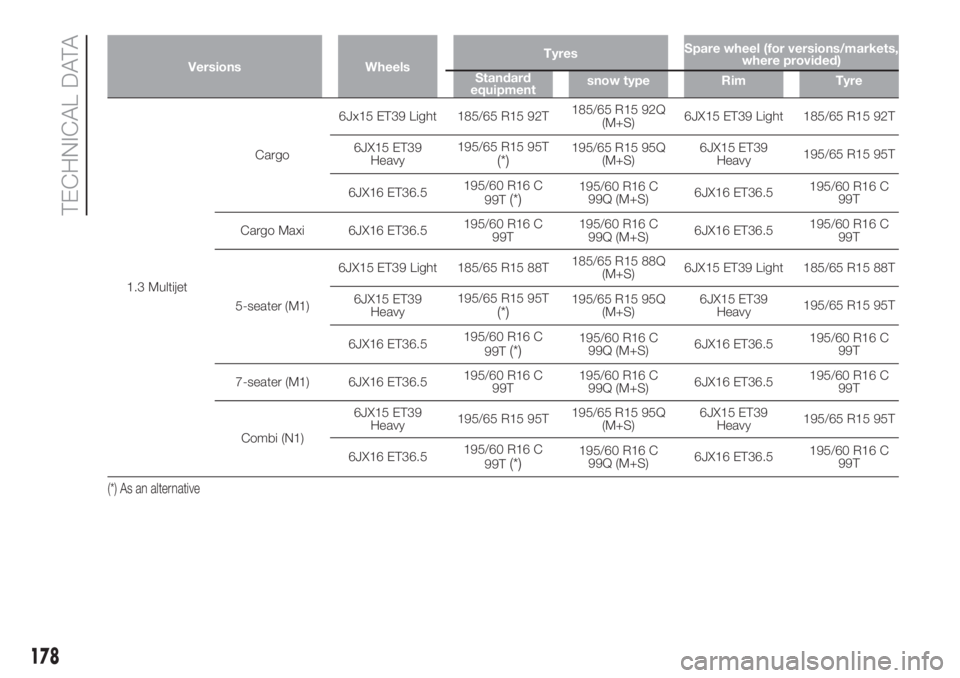
Versions WheelsTyresSpare wheel (for versions/markets,
where provided)
Standard
equipmentsnow type Rim Tyre
1.3 MultijetCargo6Jx15 ET39 Light 185/65 R15 92T185/65 R15 92Q
(M+S)6JX15 ET39 Light 185/65 R15 92T
6JX15 ET39
Heavy195/65 R15 95T
(*)195/65 R15 95Q
(M+S)6JX15 ET39
Heavy195/65 R15 95T
6JX16 ET36.5195/60 R16 C
99T
(*)195/60 R16 C
99Q (M+S)6JX16 ET36.5195/60 R16 C
99T
Cargo Maxi 6JX16 ET36.5195/60 R16 C
99T195/60 R16 C
99Q (M+S)6JX16 ET36.5195/60 R16 C
99T
5-seater (M1)6JX15 ET39 Light 185/65 R15 88T185/65 R15 88Q
(M+S)6JX15 ET39 Light 185/65 R15 88T
6JX15 ET39
Heavy195/65 R15 95T
(*)195/65 R15 95Q
(M+S)6JX15 ET39
Heavy195/65 R15 95T
6JX16 ET36.5195/60 R16 C
99T
(*)195/60 R16 C
99Q (M+S)6JX16 ET36.5195/60 R16 C
99T
7-seater (M1) 6JX16 ET36.5195/60 R16 C
99T195/60 R16 C
99Q (M+S)6JX16 ET36.5195/60 R16 C
99T
Combi (N1)6JX15 ET39
Heavy195/65 R15 95T195/65 R15 95Q
(M+S)6JX15 ET39
Heavy195/65 R15 95T
6JX16 ET36.5195/60 R16 C
99T
(*)195/60 R16 C
99Q (M+S)6JX16 ET36.5195/60 R16 C
99T
(*) As an alternative
178
TECHNICAL DATA
Page 181 of 272
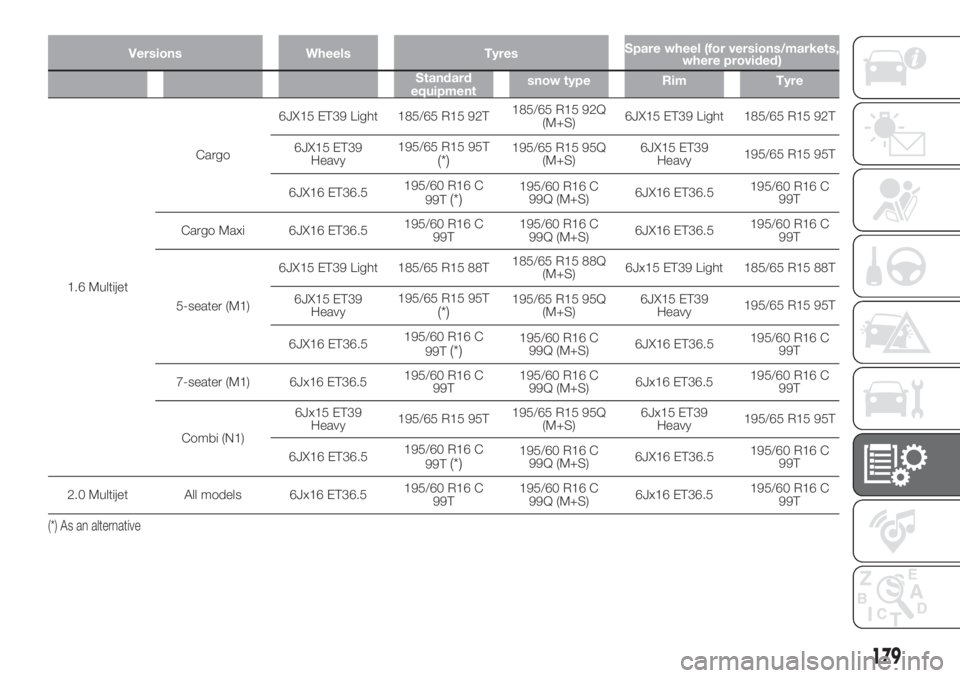
Versions Wheels TyresSpare wheel (for versions/markets,
where provided)
Standard
equipmentsnow type Rim Tyre
1.6 MultijetCargo6JX15 ET39 Light 185/65 R15 92T185/65 R15 92Q
(M+S)6JX15 ET39 Light 185/65 R15 92T
6JX15 ET39
Heavy195/65 R15 95T
(*)195/65 R15 95Q
(M+S)6JX15 ET39
Heavy195/65 R15 95T
6JX16 ET36.5195/60 R16 C
99T
(*)195/60 R16 C
99Q (M+S)6JX16 ET36.5195/60 R16 C
99T
Cargo Maxi 6JX16 ET36.5195/60 R16 C
99T195/60 R16 C
99Q (M+S)6JX16 ET36.5195/60 R16 C
99T
5-seater (M1)6JX15 ET39 Light 185/65 R15 88T185/65 R15 88Q
(M+S)6Jx15 ET39 Light 185/65 R15 88T
6JX15 ET39
Heavy195/65 R15 95T
(*)195/65 R15 95Q
(M+S)6JX15 ET39
Heavy195/65 R15 95T
6JX16 ET36.5195/60 R16 C
99T
(*)195/60 R16 C
99Q (M+S)6JX16 ET36.5195/60 R16 C
99T
7-seater (M1) 6Jx16 ET36.5195/60 R16 C
99T195/60 R16 C
99Q (M+S)6Jx16 ET36.5195/60 R16 C
99T
Combi (N1)6Jx15 ET39
Heavy195/65 R15 95T195/65 R15 95Q
(M+S)6Jx15 ET39
Heavy195/65 R15 95T
6JX16 ET36.5195/60 R16 C
99T
(*)195/60 R16 C
99Q (M+S)6JX16 ET36.5195/60 R16 C
99T
2.0 Multijet All models 6Jx16 ET36.5195/60 R16 C
99T195/60 R16 C
99Q (M+S)6Jx16 ET36.5195/60 R16 C
99T
(*) As an alternative
179